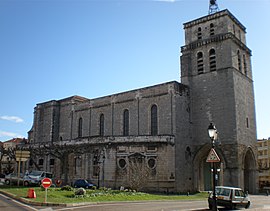Alais
| Alès | ||
|---|---|---|

|
||
|
||
| Coordinates: 44°07′41″N 4°04′54″E / 44.1281°N 4.0817°ECoordinates: 44°07′41″N 4°04′54″E / 44.1281°N 4.0817°E | ||
| Country | France | |
| Region | Occitanie | |
| Department | Gard | |
| Arrondissement | Alès | |
| Canton | Alès-1,Alès-2,Alès-3 | |
| Intercommunality | Alès Agglomération | |
| Government | ||
| • Mayor (2014-2020) | Max Roustan | |
| Area1 | 23.16 km2 (8.94 sq mi) | |
| Population (2014)2 | 39,993 | |
| • Density | 1,700/km2 (4,500/sq mi) | |
| Time zone | CET (UTC+1) | |
| • Summer (DST) | CEST (UTC+2) | |
| INSEE/Postal code | 30007 /30100 | |
| Elevation | 116–356 m (381–1,168 ft) (avg. 150 m or 490 ft) |
|
|
1 French Land Register data, which excludes lakes, ponds, glaciers > 1 km² (0.386 sq mi or 247 acres) and river estuaries. 2Population without double counting: residents of multiple communes (e.g., students and military personnel) only counted once. |
||
1 French Land Register data, which excludes lakes, ponds, glaciers > 1 km² (0.386 sq mi or 247 acres) and river estuaries.
Alès (French pronunciation: [a.lɛs]; Occitan: Alès) is a commune in the Gard department in the Occitanie region in southern France. It is one of the sub-prefectures of the department. It was formerly known as Alais.
Alès lies 40 kilometres (25 miles) north-northwest of Nîmes, on the left bank of the Gardon River, which half surrounds it. It is located at the foot of the Cévennes, near the Cévennes National Park.
Alès may be the modern successor of Arisitum, where, in about 570, Sigebert, King of Austrasia, created a bishopric. In his campaign against the Visigoths, the Merovingian king Theudebert I (533–548) conquered part of the territory of the Diocese of Nîmes. His later successor Sigebert set up the new diocese, comprising fifteen parishes in the area controlled by the Franks, which included a number of towns to the north of the Cevenne: Alès, Le Vigan, Arre, Arrigas, Meyrueis, Saint-Jean-du-Gard, Anduze, and Vissec. The diocese disappeared in the 8th century with the conquest of the whole of Septimania by the Franks. No longer a residential bishopric, Arisitum is today listed by the Catholic Church as a titular see.
...
Wikipedia



